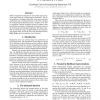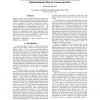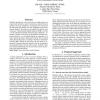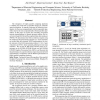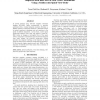114
click to vote
INTERSPEECH
2010
14 years 7 months ago
2010
Most existing binaural approaches to speech segregation rely on spatial filtering. In environments with minimal reverberation and when sources are well separated in space, spatial...
104
Voted
INTERSPEECH
2010
14 years 7 months ago
2010
Model compensation techniques for noise-robust speech recognition approximate the corrupted speech distribution. This paper introduces a sampling method that, given speech and noi...
74
Voted
INTERSPEECH
2010
14 years 7 months ago
2010
Numerous studies have documented distinctive patterns of phonetic variation associated with actual and perceived sexual orientation. This investigation tested the hypothesis that ...
INTERSPEECH
2010
14 years 7 months ago
2010
Statistical methods for voice conversion are usually based on a single model selected in order to represent a tradeoff between goodness of fit and complexity. In this paper we ass...
83
Voted
INTERSPEECH
2010
14 years 7 months ago
2010
It has been shown that large gains in speech intelligibility can be obtained by using the binary mask approach which retains the time-frequency (T-F) units of the mixture signal t...
90
Voted
INTERSPEECH
2010
14 years 7 months ago
2010
Current speech recognition systems are often based on HMMs with state-clustered Gaussian Mixture Models (GMMs) to represent the context dependent output distributions. Though high...
INTERSPEECH
2010
14 years 7 months ago
2010
The emergence of highly parallel computing platforms is enabling new trade-offs in algorithm design for automatic speech recognition. It naturally motivates the following investig...
INTERSPEECH
2010
14 years 7 months ago
2010
In speech research using real-time magnetic resonance imaging (RT-MRI), frame reconstruction is typically performed with a constant temporal resolution. However, a flexible select...
86
Voted
INTERSPEECH
2010
14 years 7 months ago
2010
This paper investigates the combination of discriminative adaptation techniques. The discriminative Maximum A-Posteriori (DMAP) adaptation and discriminative feature Maximum Likel...
65
Voted
INTERSPEECH
2010
14 years 7 months ago
2010

